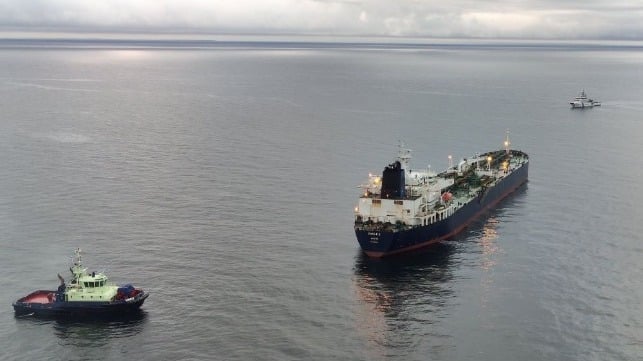Helsinki Court Dismisses Charges in Case of Cable Damage by Tanker Eagle S

The Helsinki District Court issued a surprise judgment on Friday, October 3, in the case of the master and two officers from the tanker Eagle S who had been charged with aggravated vandalism related to the damage to subsea cables. While saying the damage had occurred due to the failure of the anchor mechanism, the court ruled that it lacked jurisdiction and that it was not possible to apply Finnish criminal law to the case.
The master of the product tanker Eagle S, along with the first and second officers, was on trial for the damage to five subsea cables caused by the tanker dragging its anchor for nearly 60 miles along the Baltic seafloor. The incident took place on December 25, 2024, and Finland became the first European country to pursue legal charges, with the trial beginning at the end of August.
After six months of investigation and more than a month of court testimony, the District Court found that anchor loss was due to a failure of the anchor securing mechanism. Prosecutors had argued the officers should have been aware of the poor maintenance of the vessel and said the anchor incident was an accident “waiting to happen,” due to the condition of the ship. They argued negligence in the officers’ duties, saying they should have realized the anchor had fallen and was dragging and corrected it sooner.
The charges were brought due to the consequences for Finland’s power supply from the one damaged cable, as well as the interruption to communications from the four damaged internet cables. The court ruled, however, that the consequences of the incident did not result in the level of damage required to satisfy the statutory definition of criminal mischief or aggravated criminal mischief.
The court concluded that the incident should be classified as a navigation incident, and as such, it falls under the United Nations Convention on the Law of the Sea. While it happened within Finland’s Exclusive Economic Zone, the damage would have to be in the country for the criminal law to apply. Instead, under the UN treaty, the legal jurisdiction lies with the flag state of the vessel, in this case, the Cook Islands, or the defendant’s native state. The master and first officer are Georgians, and the second officer is from India.
Prosecutors argued the officers were responsible and should have been aware when the speed of the vessel suddenly declined. The defense argued it was an accident and that the chief engineer said the speed decline was due to an engine problem. They also blamed heavy weather for contributing to the loss of the anchor.
The Eagle S stopped in Finland and was boarded by Finnish forces the day after the incident. They held the vessel till March 2025 for safety violations as the investigation into the cable damage proceeded. Eight crewmembers and the master were also ordered not to leave Finland, with one released the following month and five more released at the end of February. The Helsinki District Court lifted the travel ban for the master and the two officers in September at the end of the trial, and they have all left Finland.
The court noted that there was no allegation in the case of the defendants’ having intentionally damaged the five subsea cables. Further, while there had been wide speculation linking the incident to Russia, there was no discussion of Russia in the charges. However, it came out in court that the vessel’s Voyage Data recorder was not functioning, and there were allegations that the ship’s manager told the master to destroy communications and not provide information during the investigation.
The jurisdictional issues raised in Finnish law cast doubt on other efforts to prosecute similar instances of cable damage despite the allegation that it is part of a cloaked hybrid form of war. There have been several unresolved cases of damage in the Baltic and elsewhere. Taiwan prosecuted a captain of a Chinese-owned cargo ship in a case of cable damage, and China has started a trial related to an October 2023 incident when a Chinese-owned containership, the NewNew Polar Bear, also dragged its anchor in the Baltic, damaging a gas and telecom pipeline connecting Finland and Estonia.
The incident with the Eagle S created a new level of awareness and concern over the potential damage to undersea assets. The Scandinavian and Baltic countries, NATO, and the UK have all increased their monitoring of assets. This week, the Europeans announced new efforts aimed at the shadow fleet of tankers after new allegations that the vessels are linked to drone incidents taking place over Northern Europe. Russia has vowed to protect the tankers and called the inspections interference and piracy, while the EU is intent on interrupting the vessel to protect the environment, guard against possible sabotage, and disrupt Russia’s income from the oil trade.
